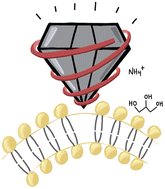We use diamond nanoparticles (DNPs) wrapped in the cationic polyelectrolyte poly(allylamine) hydrochloride (PAH) and bilayers composed of either pure DOPC or a mixture of DOPC/DOPG to investigate the influence of membrane phospholipid composition and net surface charge on nanoparticle-membrane interactions and the extent of nanoparticle adhesion to supported phospholipid bilayers. Our results show that in all cases electrostatic attractions between the negatively charged bilayer and cationic PAH-DNP were responsible for the initial attachment of particles, and the lateral electrostatic repulsion between adsorbed particles on the bilayer surface determined the final extent of PAH-DNP attachment. Upon attachment, NPs attract lipids by the contact ion pairing between the ammonium groups on PAH and phosphate and glycerol groups on the lipids and acquire a lipid corona. Lipid corona formation on the PAH-DNP reduces the effective charge density of the particle and is in fact a key factor determining the final extent of NP attachment to the bilayer. Incorporation of DOPG to the bilayer leads to a decrease in efficiency and final extent of attachment compared to DOPC alone. The reduction in PAH-DNP attachment in the presence of DOPG is attributed to the adsorption of free PAH in equilibrium with bound PAH in the nanoparticle solution, thus reducing electrostatic attraction between PAH-DNPs and SLBs. This leads to an increase in hydrogen bonding interactions between lipid headgroups that limits extraction of phospholipids from the bilayer by PAH-DNP, lessening the reduction in interparticle repulsion achieved by acquisition of a lipid corona. Our results indicate that the inclusion of charged phospholipids in SLBs changes bilayer rigidity and stability and hinders the attachment of PAH-DNPs by preventing lipid extraction from the bilayer.
